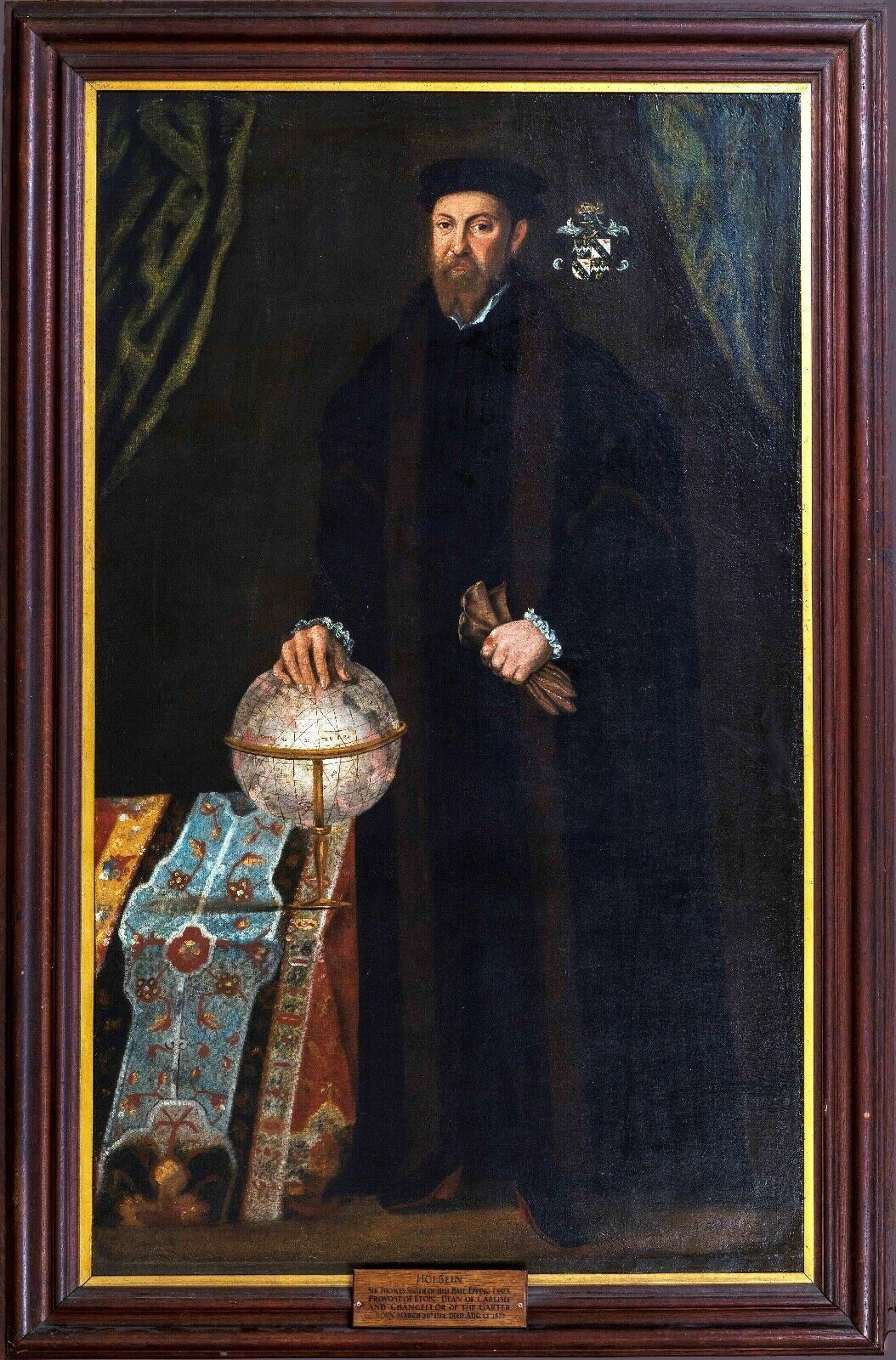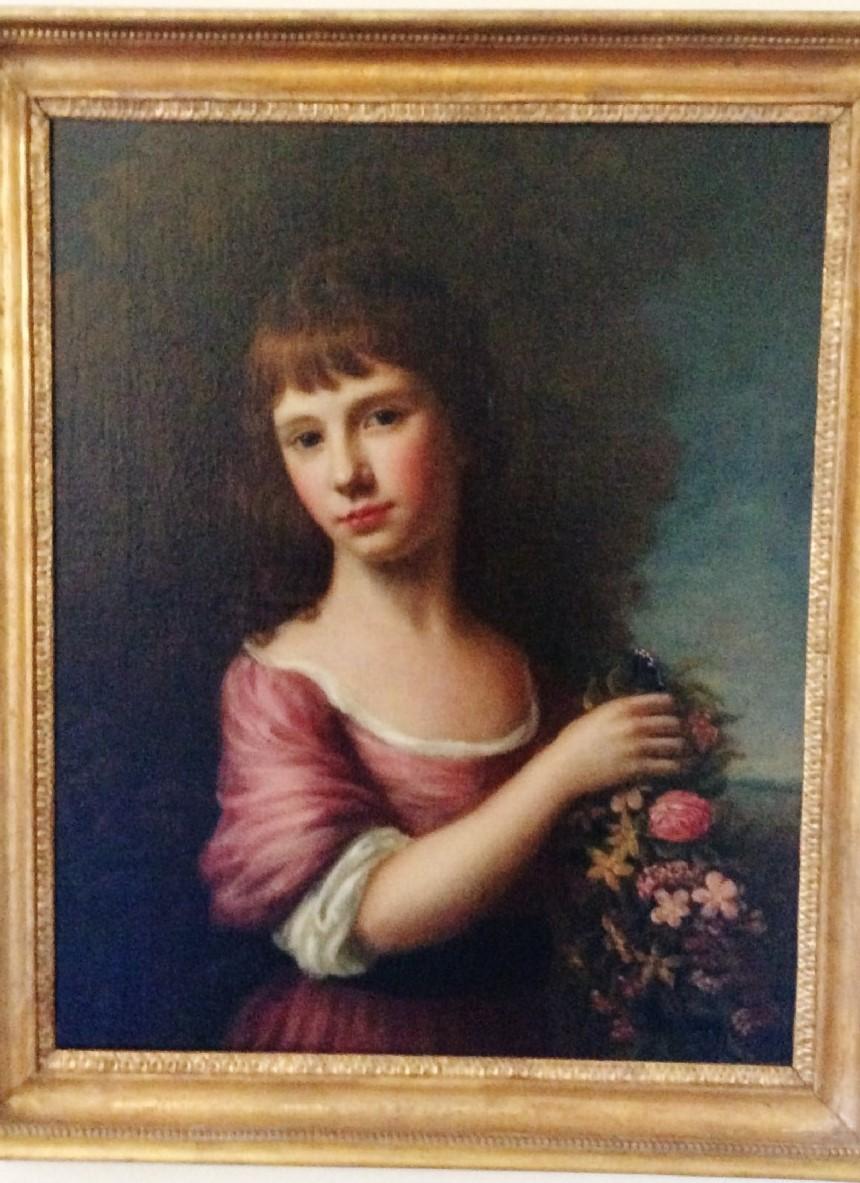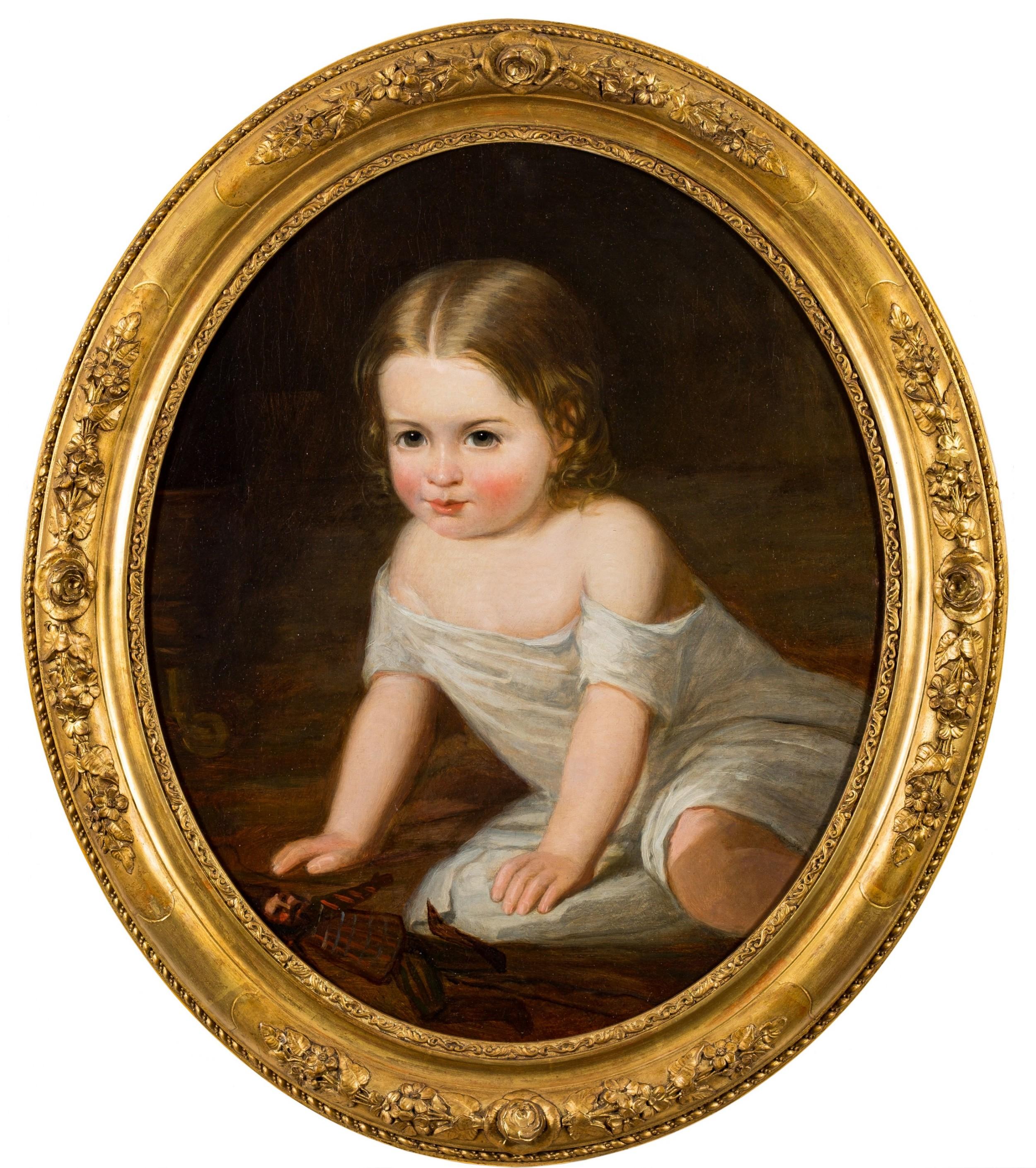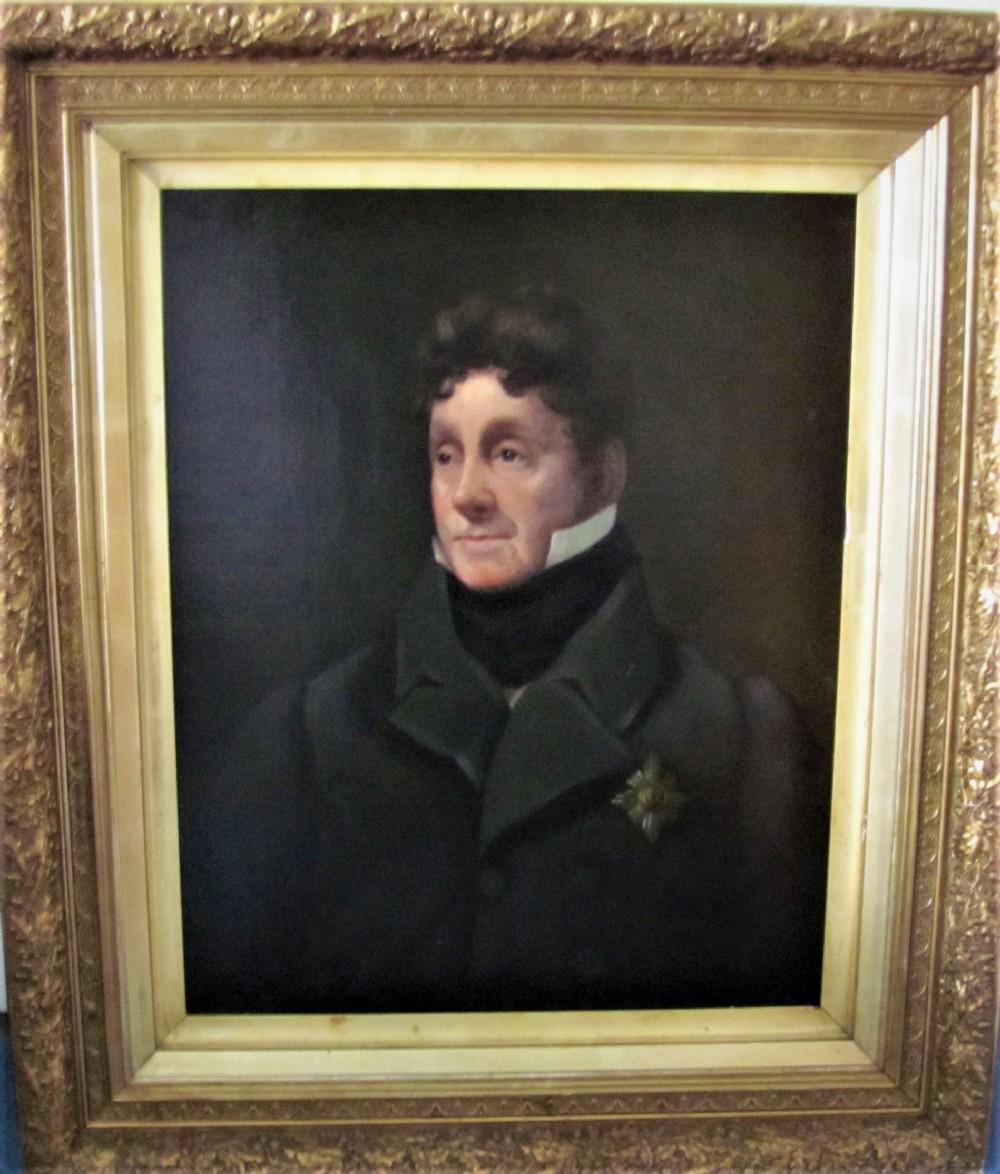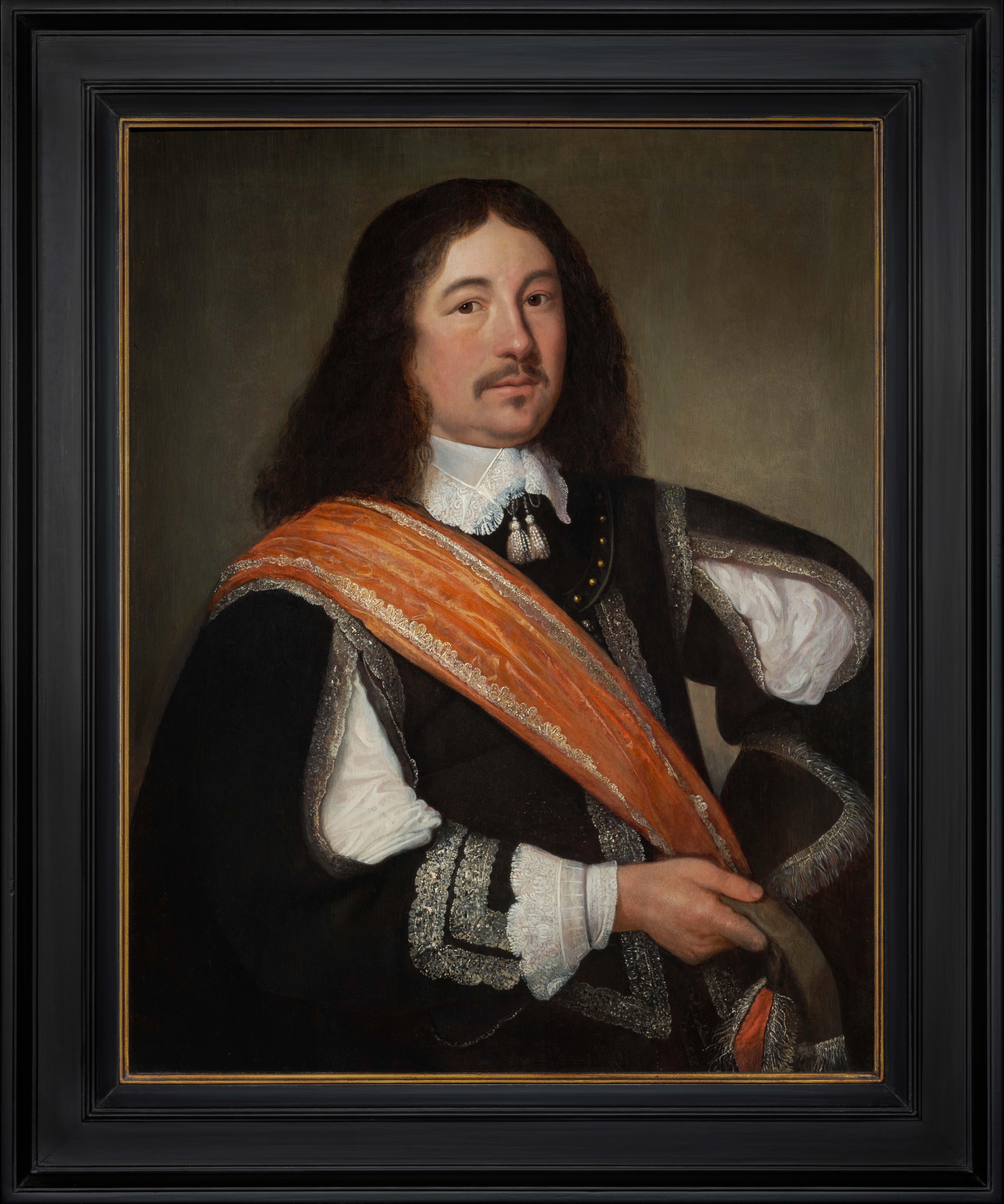Items Similar to Equestrian Portrait Kraeck Paint Oil on canvas Old master 16/17th Century Italy
Want more images or videos?
Request additional images or videos from the seller
1 of 17
Equestrian Portrait Kraeck Paint Oil on canvas Old master 16/17th Century Italy1590-1620
1590-1620
About the Item
Jan Kraeck, in Italy Giovanni Caracca (Haarlem c. 1540 - Turin 1607) Workshop of
Equestrian portrait of Charles Emmanuel I, Duke of Savoy (Rivoli 1562 - Savigliano 1630) known as 'the Great'
Oil on canvas (148 × 122 cm - Framed 165 × 139 cm)
The work is also accompanied by an expert's report by Dr. Arabella Cifani, which traces it back to a pupil of the master, Giulio Maino (1570 - after 1643)
The subject of this fascinating equestrian portrait is Charles Emmanuel I, Duke of Savoy (Rivoli 1562 - Savigliano 1630), immortalised in adulthood, proudly mounted on the back of his white horse, in his sumptuous ceremonial armour trimmed with fine gold ornaments. He wears short hair, a pointed beard and moustache, with a lace ruff around his neck.
Nicknamed 'Firehead' by his subjects, due to his manifest military aptitude and impetuous character, he was one of the most capable and cultured princes in the history of the House of Savoy; his birth was announced to the family by Nostradamus, in 1561, who added that he would become 'the greatest leader of his time'.
He married the daughter of Philip II of Spain, Catherine Michela, confirming the traditional link of his lineage with the Habsburgs of Spain.
Ambitious and self-confident, thanks to the excellent state of the Duchy he had inherited from his father, he sought to expand his power territorially: he left the Duchy of Savoy an administrative, diplomatic and military organisation of an efficiency and solidity never known in the past, achieved with the contribution of the Piedmontese officials he surrounded himself with. Turin was enriched with churches, palaces and monuments, and the Savoy court became Italy's leading cultural centre thanks to intellectuals from all over the peninsula.
Our fine portrait stands out for the pose of the valiant noble knight who sits firmly on the back of his steed and holds the staff of command.
The armour, in its sumptuousness and richness, recalls those in use at the Spanish court and with the Habsburgs, as shown by the portraits of artists working for Spanish kings between the 16th and 17th centuries: for example, the famous Charles V on horseback by Titian (1548, Prado Museum), the Equestrian Portrait of Charles V of Habsburg (c. 1620, Uffizi, Florence) and the Portrait of Charles I of England (1640, Prado Museum), both by Van Dyck, with a type of portrait that glorified and emphasised the strength and magnificence of the immortalised ruler.
The work is undoubtedly by an artist/collaborator from the workshop of the Flemish painter Jan Kraeck (Haarlem 1540 - Turin 1607), known by the Italianised name of Giovanni Caracca, who was mainly active as a painter at the Savoy court, working both in the service of Emanuele Filiberto I and for his son Carlo Emanuele I of Savoy between 1568 and 1607, and engaged in the most important works promoted by the dynasty.
During his stay at the Savoy court, Caracca produced numerous portraits, and in particular we must mention the series dedicated to the depiction of the entire genealogy of the Counts and later Dukes of Savoy, commissioned at the beginning of the 17th century by Charles Emmanuel I for his Grand Gallery (which united the Castle and the Ducal Palace), which were however destroyed by fire in 1659.
The equestrian portrait of Charles Emmanuel I, in particular, was in fact replicated by Caracca and his workshop on several occasions, one of which was for the Great Gallery, for which he also painted the image of his father Emmanuel Philibert I. This series of canvases, with portraits strictly on horseback, as Caracca himself had designed, was initially intended to appear above the wardrobe cupboards, with the effigies standing out majestically from the top of the great corridor.
Our painter's portrait production was strongly influenced by his encounter with the artists working at the Spanish court in 1585, on the occasion of the wedding between Charles Emmanuel I and the Enfanta of Spain, Catherine Michela, daughter of Philip II. His encounter with the portrait painters at the Spanish court oriented his production, initially based only on the model of late 16th century French portraiture, towards the canons of the 'International Court Portrait' with a focus on the painting of Alonso Sanchez Coello and Antonio Moro.
ADDITIONAL INFORMATION:
The painting is sold complete with an attractive antique gilded frame and is accompanied by a certificate of authenticity and descriptive iconographic card.
We take care of and organise the transport of the purchased works, both for Italy and abroad, through professional and insured carriers.
Should you have the desire to see this or other works in person, we will be happy to welcome you to our new gallery by Antichità Castelbarco SRLS in Riva del Garda, Viale Giuseppe Canella 18. We are waiting for you!
Contact us for any information or to arrange a visit, we will be happy to answer you.
- Creation Year:1590-1620
- Dimensions:Height: 64.97 in (165 cm)Width: 54.73 in (139 cm)
- Medium:
- Movement & Style:
- Circle Of:Jan Kraeck, in Italy Giovanni Caracca (Haarlem c. 1540 - Turin 1607) (1540 - 1607)
- Period:
- Condition:
- Gallery Location:Riva del Garda, IT
- Reference Number:1stDibs: LU988112470092
About the Seller
4.8
Platinum Seller
These expertly vetted sellers are 1stDibs' most experienced sellers and are rated highest by our customers.
Established in 2017
1stDibs seller since 2018
207 sales on 1stDibs
Typical response time: <1 hour
- ShippingRetrieving quote...Ships From: Riva del Garda, Italy
- Return PolicyA return for this item may be initiated within 7 days of delivery.
More From This SellerView All
- Portrait De La Fosse Rigaud Paint Oil on canvas 17/18th Century Old master ArtLocated in Riva del Garda, ITHyacinthe Rigaud (Perpignan 1659 - Paris 1743) attributable Portrait of the painter Charles de La Fosse (1636-1716) oil on canvas 60 x 52 cm/ In a beautiful frame cm. 113 x 78 The ...Category
18th Century Old Masters Paintings
MaterialsOil
- Polyphemus Galatea Carracci Paint 17th Century Oil on canvas Old master ItalyLocated in Riva del Garda, ITAnnibale Carracci (Bologna, 1560 - Rome, 1609) Workshop of Polyphemus and Galatea (or Polyphemus in love) First half of the 17th century Oil on canvas 75 x 62 cm. - In antique fram...Category
17th Century Old Masters Paintings
MaterialsOil
- Saint Jerome Oil on copper 16th Century Paint Old master Italy Emilian schoolBy Giuseppe Mazzuoli known as Bastarolo (Ferrara 1536 - 1589)Located in Riva del Garda, ITFerrara school of the late sixteenth century - circle of Giuseppe Mazzuoli known as Bastarolo (Ferrara 1536 - 1589) St. Jerome penitent in the cave ...Category
16th Century Old Masters Paintings
MaterialsOil
- Pietà Cherubs Paint Oil on canvas Religious Rome 16/17th Century MichelangeloLocated in Riva del Garda, ITPeintre actif à Rome au XVIe siècle - entourage de Scipione Pulzone (Gaeta 1550 - Rome 1598) La Pietà (Christ mort soutenu par la Madone) huile sur t...Category
16th Century Old Masters Paintings
MaterialsOil
- Madonna Child Tiarini Paint Oil on canvas Old master 17th Century Italy BaroqueBy Alessandro Tiarini (Bologna, 1577 - 1668)Located in Riva del Garda, ITEmilian Caravaggesque painter of the early seventeenth century Alessandro Tiarini (Bologna, 1577 - 1668), attributable Madonna and Child Early seve...Category
17th Century Old Masters Paintings
MaterialsOil
- Portrait Mignard Paint Oil on canvsa Old master 17th Century French Lady WomanLocated in Riva del Garda, ITPierre Mignard, known as Le Romain (Troyes 1612 - Paris 1695), attributed Portrait of 'Louise Renée de Penancoët de Keroualle, Duchess of Portsmouth and Aubigny (Brest 1649 - Paris 1734) as MADDALENA Oil on canvas 97 x 88 cm In an important gilded frame 132 x 122 cm. Provenance: Private collection, Naples The young and attractive noblewoman portrayed in this painting is Louis Renée de Penancoet de Keroualle, Duchess of Portsmouth and Aubigny (Brest 1649 - Paris 1734), known to have been King Charles II's favourite mistress for over fifteen years, from whose relationship Charles Lennox, 1st Duke of Richmond, was born, but above all to have gone down in history as one of Louis XIV's French informants at the English court. The duchess was a very influential figure at court, promoting French interests and often acting as an intermediary between the king, his ministers and French ambassadors. After the death of Charles II this influence quickly came to an end, forcing her to hastily leave London and renounce all her possessions to return to her homeland, between Aubigny-sur-Nère and Paris, where she died in 1734, always remaining in the sovereign's good graces. The peculiarity of the portrait, probably executed after her return to her homeland, is that the noblewoman takes the form of a charming Mary Magdalene, depicted here following her renunciation of earthly possessions, her rich robes and jewellery, in order to aspire to heavenly riches; We see her immortalised with her long hair loose on one breast, her intriguing but serene gaze directed at the observer, as she rests her crossed hands, as if in prayer, on the ampulla of perfumed ointments and the open book, both iconographic symbols. The custom of being portrayed in the guise of Magdalene was in vogue for powerful women of the great European courts as early as the 16th century, as it represented the most appropriate image to justify the union of female power and virtue. It must be said that court culture exalted only the positive characteristics of her personality, glossing over or downplaying all references to her sinful past and dissolute life. The work, whose style fits perfectly into 17th century French portraiture, suggests the pertinent attribution to the Baroque painter Pierre Mignard (Troyes, 1612 - Paris, 1695), whose works were highly praised and earned him a great reputation as a portrait painter for the demanding Parisian aristocracy at the time of Louis XIV, and who portrayed the Duchess de Kérouaille on numerous occasions. His first important artistic training took place in Simon Vouet's studio, and he then moved to Italy for over twenty years before returning to Paris, blending his own with the influence of Roman classicism. The elegant looseness of touch and sensual refinement typical of Mignard, combined with a very accurate chiaroscuro rendering, inherited from his artistic training in Rome (which he looked up to the examples of Ferdinad Voet), and the exceptional sweetness of the drawing, the floridity of the complexion and the almost enamelled surfaces, and finally, the peculiar pose of the figure portrayed (the beauty of the two intertwined hands...Category
17th Century Old Masters Paintings
MaterialsOil
You May Also Like
- Portrait Of Thomas Smythe (1514-1577) School of Hans HOLBEIN (1497-1543)By Hans HolbeinLocated in Blackwater, GBPortrait Of Thomas Smythe (1514-1577), 16th Century School of Hans HOLBEIN (1497-1543) Fine huge 16th Century English Old Master portrait of Sir Thomas...Category
16th Century Old Masters Portrait Paintings
MaterialsOil
- William Wissing (follower) 19th Century Portrait Queen Mary IILocated in York, GBA 19th century oil on canvas, portrait of a young woman.This portrait is believed to be of Queen Mary II taken from an engraving of the painting, Halswell Park Sale, 1948, lot no.1323, Housed in a decorative gilt frame.Size overall being 70 x 86 cm high (27.5 x 33¾ inches approx) size of painting 54 x 68 cm (21 x 26 inches approx) To the rear of the portrait is a newspaper cutting of the engraving ,also a typed note regarding the provenance of the painting (see photo) Condition overall is very good, the Canvas has been relined, under UV there are areas of overpaint to bosom.Frame overall very good some minor self coloured losses Mary II (30 April 1662 – 28 December 1694) Mary, born at St James's Palace in London on 30 April 1662,eldest daughter of James, Duke of York (the future James II & VII) , and his first wife, Anne Hyde. Mary's uncle was King Charles II, her maternal grandfather, Edward Hyde, 1st Earl of Clarendon, served for a lengthy period as Charles's chief adviser. Mary married William of Orange. Willem Wissing, known in England as William Wissing...Category
19th Century Old Masters Portrait Paintings
MaterialsOil
- Nathaniel Hone, portrait of "flora" roman goddess, 18th centuryBy Nathaniel Hone the ElderLocated in York, GBI have great pleasure in offering for sale this beautiful portrait, by Nathaniel Hone, the elder. 18th century. The painting is of Ann Anderson, wife...Category
18th Century Old Masters Portrait Paintings
MaterialsOil
- 19th Century Portrait, Child At Play , Attributed To Henry Tanworth WellsLocated in York, GB19th century portrait, child at play ,Attributed to Henry Tanworth Wells A beautiful oval portrait of a young child at play, attributed to the portrait painter Henry Tanworth Wells. finely executed, this oil on canvas is in excellent condition. Housed in a period frame. The size overall is 79 cm x 62 cm whilst the painting is 56 cm x 46 cm Henry Tanworth Wells [1828-1903] Henry Tanworth Wells RA was an English miniature and portrait painter. He was a member of the Pre-Raphaelite circle though he painted in the academic style. His most popular painting...Category
19th Century Old Masters Portrait Paintings
MaterialsOil
- Henry Raeburn, (circle) 19th Century portrait of Sir Charles Forbes EdinglassieBy Henry Raeburn (circle)Located in York, GBPortrait of Sir Charles Forbes of Edinglassie, Oil on canvas. The size of the portrait is 75 cm x 59.5 cm whilst overall the size is 106 cm x 91 cm In very good condition.There has been some restoration/overpainting etc.There is some minor craquelure. Housed in a period gilt frame decorated with acorns and leaves Overall a good portrait, circle of a fine scottish artist , with an interesting sitter, his details below. sir Charles Forbes of Edinglassie Sir Charles Forbes, 1st Baronet (1774–1849) was a Scottish politician, of Newe and Edinglassie, Aberdeenshire. Forbes was the son of the Rev. George Forbes of Lochell. He was a descendant of Alexander Forbes of Kinaldie and Pitsligo, and was in 1833 served heir male in general to Alexander Forbes, 3rd lord Forbes of Pitsligo, father of Alexander Forbes, 4th Lord Forbes of Pitsligo, attainted in 1745. Forbes was of a bluff but kindly nature, diffident as to his own merits, of a straightforward and manly character. On the death of his uncle in 1821 Forbes succeeded to the entailed estates of the Forbeses of Newe, and was created a baronet by patent in 1823.[1] He married in 1811. His daughter, Elizabeth, married General, Lord James Hay, second son of the seventh Marquess of Tweeddale. Sir Henry Raeburn FRSE, RA, RSA (1756-1823) Scottish portrait painter and Scotland's first significant portrait painter since the Union to remain based in Scotland. He served as Portrait Painter to King George IV in Scotland Raeburn had all the essential qualities of a popular and successful portrait painter. He was able to produce a telling and forcible likeness; his work is distinguished by powerful characterisation, stark realism, dramatic and unusual lighting...Category
19th Century Old Masters Portrait Paintings
MaterialsOil
- Portrait Gentleman Black Coat Orange Sash, Dutch Old Master, Oil on Panel c.1650By Bartholomeus van der HelstLocated in London, GBThis exquisite portrait of a gentleman depicted in a sumptuous black coat edged with silver and slashed sleeves is an excellent example of the type of portrait fashionable in England and the Low Countries during the 17th century. The confident pose, striking orange sash - the colour of the house of Orange Nassau - and the leather gorget imbue the sitter with a sense of masculinity and power. The profusely decorated costume is of the highest quality and de rigueur of an elite class - the artist has carefully cultivated this portrait to emphasise the sitter’s wealth and standing in the society that he belonged to. The casual pose, with one arm resting on a hip, is much less formal than earlier decades, and it speaks of ‘sprezzatura’ – one’s appearance should not appear laborious, but instead, effortless. The oil on cradled panel portrait can be dated to circa 1650 based on the hairstyle and the attire - small falling collar, short doublet (doublets reduced in size to just below the ribcage in the late 1650’s), and the type of slashed sleeves with the sleeve seams left open to reveal the white fabric. The demand for portraits in the Netherlands was great in the 17th century. Bartholemeus van der Helst was considered to be one of the leading portrait painters of the Dutch Golden Age surpassing even Rembrandt as the most sought-after portraitist in Harlaam. The Dutch Golden Age, roughly spanning the 17th century, was a period when Dutch trade, science, military, and art were among the most acclaimed in the world. Dutch explorers charted new territory and settled abroad. Trade by the Dutch East-India Company thrived, and war heroes from the naval battles were decorated and became national heroes. During this time, The Dutch Old Masters began to prevail in the art world, creating a depth of realistic portraits of people and life in the area that has hardly been surpassed. The Golden Age painters depicted the scenes that their discerning new middle-class patrons wanted to see. This new wealth from merchant activities and exploration combined with a lack of church patronage, shifted art subjects away from biblical genres. Still life’s of items of everyday objects, landscapes, and seascapes reflecting the naval and trade power that the Republic enjoyed were popular. The new wealthy class were keen to have their portraits commissioned and many artists worked in this lucrative field. Such was the popularity of art that everyone had a painting, even the humble butcher, and hundreds of thousands of paintings were produced. By tradition the sitter is Maarten Tromp (1598-1653) who was an Admiral in the Dutch Navy (the reverse of the portrait contains an old handwritten inscription “van Tromp”). Certainly, the distinctive orange sash is similar to those worn by officers of the Dutch army in the Netherlands who served under the Princes of Orange and the House of Nassau. However, it should be noted that the physiognomy differs from other images of Tromp. Tromp was the oldest son of Harpert Maertensz, a naval officer and captain. He joined the Dutch navy as a lieutenant in July 1622 and was later promoted from captain to Lieutenant-Admiral of Holland and West Frisia in 1637. In 1639, during the Dutch struggle for independence from Spain, Tromp defeated a large Spanish fleet bound for Flanders at the Battle of the Downs, which marked an enormous change - the end of Spanish naval power. He was killed in action during the First Anglo-Dutch War in 1653 where he commanded the Dutch fleet in the battle of Scheveningen. Gloves were an absolutely vital accessory and the elaborate pair in this portrait are embellished with threads of silk and precious metals and salmon-coloured lining. He wears only one glove and holds the other, providing an opportunity to better display the cuffs and detail on his right wrist and forearm. The gloves are probably made from the most prized leather which came from Spain, in particular from Cordova. Cordovan leather was tanned with a special vegetal process that left it both highly impermeable and divinely soft. King Charles I, posed in a rather relaxed manner for Daniel Mytens’s portrait in 1631, is wearing gloves and boots in matching Cordovan leather. The hide is thick, but you can see just how supple it is from the way the gauntlet dimples and the long boot legs fold over themselves, rippling and wrinkling at the ankles. Apart from keeping hands warm the use of gloves during the 15th through the 19th centuries were full of symbolism and they were worn regardless of the season. They kept the skin unblemished - soft, smooth hands were considered highly attractive. This combination of necessity and proximity to bare skin made gloves a deeply personal gift and they took on a strong symbolic significance and were regarded as emblematic of fidelity and loyalty for hundreds of years. Such was the importance of their symbolism was that some gloves were never intended to be worn at all. Their luxury made them ideal gifts at court, and so in the 15th and 16th centuries, ambassadors often presented them as symbols of loyalty. Until the mid-19th century, it was customary to give gloves as tokens to guests at weddings and to mourners at funerals. Gentleman often gifted their bride-to-be with a pair of gloves (the obligatory gift) and were handed over at the betrothal and put on display before the wedding took place. It was probably their direct contact with the skin that led to the eroticism of gloves. Not only were pairs often exchanged between lovers, but from the 16th to the 18th centuries, it was common practice to remove one glove and give it as a gift to a favourite. The idea of the item being presented still warm from the wearer’s hand is certainly suggestive. Following the death of King George IV, his executors purportedly found over a thousand mismatched ladies’ gloves among his possessions. The sentiment of a 17th-century poem reveals the popularity of the practice: “Come to our wedding to requite your loves / Shew us your hands and we’ll fit you with gloves.” Such generosity might be pricey for the hosts, but gloves of varying quality could be offered depending on the status of the recipient. Pairs made with the finest Spanish leather might be reserved for immediate family, while coarse sheep’s leather could be distributed among the servants and tradesmen. The apportioning of quality according to class provided a very clear message of the gloves’ intended use. For refined guests, they were decoration; for the lower classes, they were functional. Bartholomeus van der Helst...Category
17th Century Old Masters Portrait Paintings
MaterialsOil, Wood Panel
Recently Viewed
View AllMore Ways To Browse
Italy Antique
Excellent Italian
Old Paint
Italian Oil Art
All Master Paintings
Italian Fine Painting
16 Century Paintings
Old Italian Artist
In Old England
Great Masters Art
Great Masters Painting
Italian Master Painting
Italian Oil Painters
Oil Painting By Italian Painters
Master Spain
Past Master
16 Century Oil Paintings
Italian Old Masters
